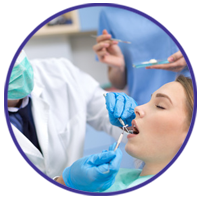Sedation Dentistry
Many people do not visit the dentist for regular check-ups because they are too scared or have dental anxiety. Sedation dentistry offers a way to provide a safe, anxiety-free, dental experience to those who are afraid of visiting the dentist. Sedation dentistry is often mistakenly thought to induce sleep. In fact, most sedatives allow for the patient to be awake during the procedure. Sleepiness is a side effect of some medications, but nitrous oxide, oral conscious sedation and IV sedation only work to calm anxiety throughout the dental visit. Sedation dentistry is popular because most sedatives can be taken orally, meaning no injections, anxiety or pain. Some sedatives work so well that even the smells and details of the procedure cannot be recognized afterwards.
Advantages of Sedation Dentistry:
- Anxiety is alleviated
- More can be accomplished during each visit
- No pain
- Perfectly safe
- Procedures can take less time
What sedatives are available?
The most widely used dental sedatives are nitrous oxide, oral conscious sedation, and IV sedation. Different levels of sedation (mild, moderate and deep) can be utilized depending on the patient’s needs. Before using any sedative, the dentist must analyse the medical history of the patient, as well as taking note of any current medications.
Here is an overview of some of the most common types of dental sedatives:

Nitrous Oxide
Nitrous oxide, or “laughing gas,” is used as a mild sedative. It is delivered through a nose hood, and is administered throughout the entire procedure. Nitrous oxide elevates the general mood and can evoke a general sense of well-being. It relieves anxiety and reduces pain during the procedure. Some tingling and numbness may be felt. There are minimal side effects that come with nitrous oxide, and it has been safely used in dentistry for many years.
IV Sedation
Intravenous sedation is a moderate type of sedation. Patients who have had IV sedation before report feeling like they slept through the entire procedure. Generally, IV sedation is used for shorter treatments. It is administered by injection into the bloodstream, which means it is effective immediately. Sometimes patients feel groggy when the IV sedatives are withdrawn. This is why it is important to have a driver for your ride home.
Oral Conscious Sedation
Oral conscious sedation is a good alternative for people who don’t like needles. Oral medication is provided prior to treatment in order to induce a moderate state of sedation. Though oral sedatives do not cause sleep, they usually dull the senses. Most patients cannot remember the pain, smells or sounds associated with the procedure. Usually, a dose of medication is taken before the appointment, and then topped up during the procedure as required.
